Determining Taxable Income and Allowable Deductions under Taxation Law
VerifiedAdded on 2023/06/11
|12
|2334
|127
AI Summary
This article discusses the determination of taxable income and allowable deductions under taxation law using a case study of Kate. It covers the rules and applications of various sections of the ITAA 1997 and FBTAA 1986.
Contribute Materials
Your contribution can guide someone’s learning journey. Share your
documents today.

Running head: TAXATION LAW
Taxation Law
Name of the Student
Name of the University
Authors Note
Course ID
Taxation Law
Name of the Student
Name of the University
Authors Note
Course ID
Secure Best Marks with AI Grader
Need help grading? Try our AI Grader for instant feedback on your assignments.
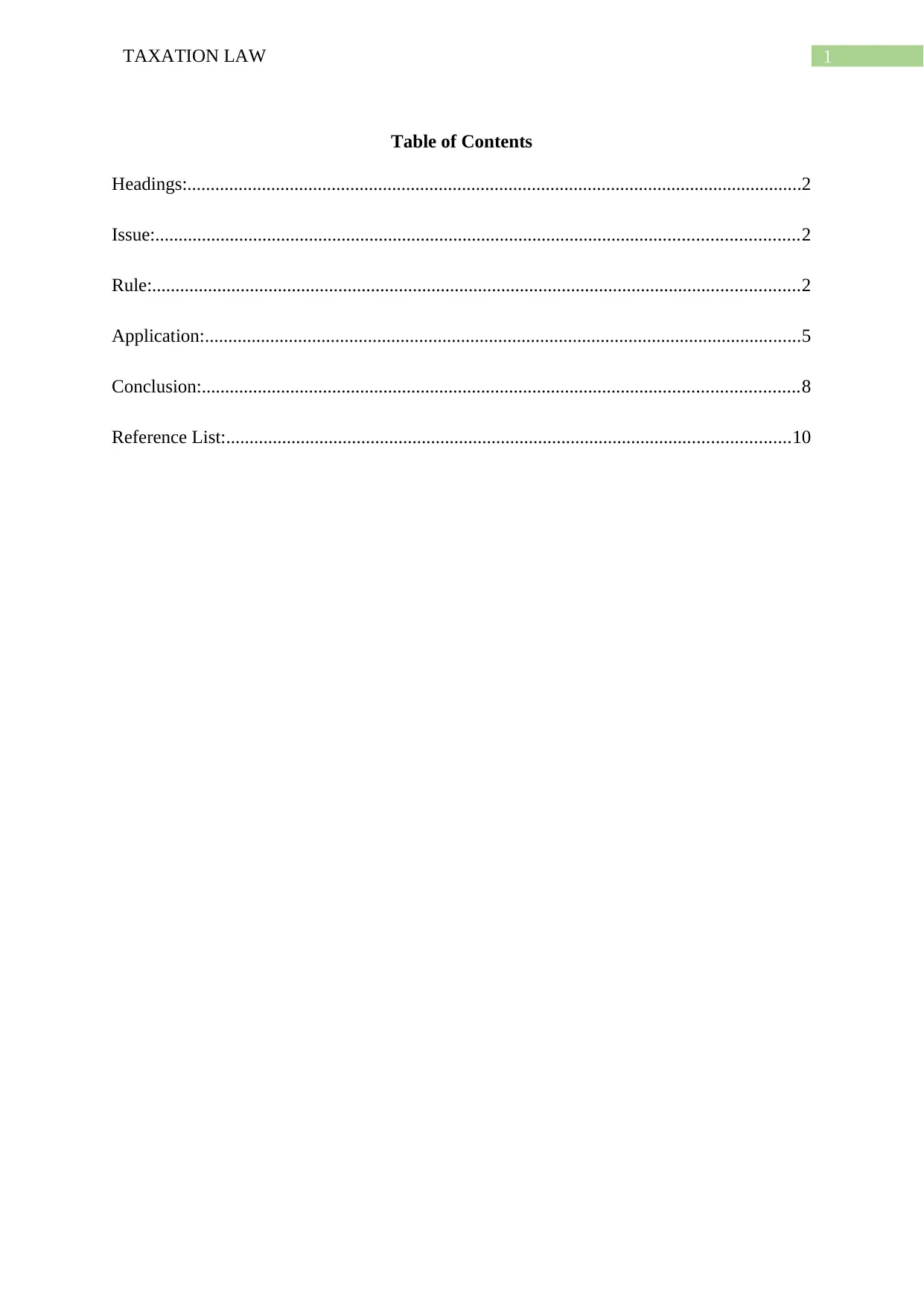
1TAXATION LAW
Table of Contents
Headings:....................................................................................................................................2
Issue:..........................................................................................................................................2
Rule:...........................................................................................................................................2
Application:................................................................................................................................5
Conclusion:................................................................................................................................8
Reference List:.........................................................................................................................10
Table of Contents
Headings:....................................................................................................................................2
Issue:..........................................................................................................................................2
Rule:...........................................................................................................................................2
Application:................................................................................................................................5
Conclusion:................................................................................................................................8
Reference List:.........................................................................................................................10

2TAXATION LAW
Headings:
The following scenario would be determining the taxable income of Kate during the
year ended 2017/18 and would also considered whether the expenditure is allowed as
deductions under “section 8-1 of the ITAA 1997”?
Issue:
The following issue is associated with the determination of the taxable income of
Kate and determining whether the she would be held assessable for ordinary income reported
during the year 2017? The issue takes into the consideration whether Kate would be
permitted to claim an allowable deduction under “section 8-1 of the ITAA 1997”?
Rule:
Denoting the explanation of “section 6-1 of the ITAA 1997” an individual taxpayer is
considered for taxation purpose for the income derived from the personal sources1. This
includes salary income, wages, bonus, fees, allowances or revenue from the business carried
on by the taxpayer. As stated under the “section 6-5 of the ITAA 1997” ordinary income of
the taxpayer constitutes income that comes into the taxpayer. In “Scott v Commissioner of
Taxation (1935)” the expression income should be ascertained in agreement with the
ordinary concepts.
As noted in “section 136 (1) of the FBTAA 1986” fringe benefit constitutes where a
company offers benefit to the employee for their employment2. With reference to “section 20
1 Woellner, Robin, et al. "Australian Taxation Law 2016." OUP Catalogue (2016).
2 Barkoczy, Stephen. "Foundations of taxation law 2016." OUP Catalogue (2016).
Headings:
The following scenario would be determining the taxable income of Kate during the
year ended 2017/18 and would also considered whether the expenditure is allowed as
deductions under “section 8-1 of the ITAA 1997”?
Issue:
The following issue is associated with the determination of the taxable income of
Kate and determining whether the she would be held assessable for ordinary income reported
during the year 2017? The issue takes into the consideration whether Kate would be
permitted to claim an allowable deduction under “section 8-1 of the ITAA 1997”?
Rule:
Denoting the explanation of “section 6-1 of the ITAA 1997” an individual taxpayer is
considered for taxation purpose for the income derived from the personal sources1. This
includes salary income, wages, bonus, fees, allowances or revenue from the business carried
on by the taxpayer. As stated under the “section 6-5 of the ITAA 1997” ordinary income of
the taxpayer constitutes income that comes into the taxpayer. In “Scott v Commissioner of
Taxation (1935)” the expression income should be ascertained in agreement with the
ordinary concepts.
As noted in “section 136 (1) of the FBTAA 1986” fringe benefit constitutes where a
company offers benefit to the employee for their employment2. With reference to “section 20
1 Woellner, Robin, et al. "Australian Taxation Law 2016." OUP Catalogue (2016).
2 Barkoczy, Stephen. "Foundations of taxation law 2016." OUP Catalogue (2016).
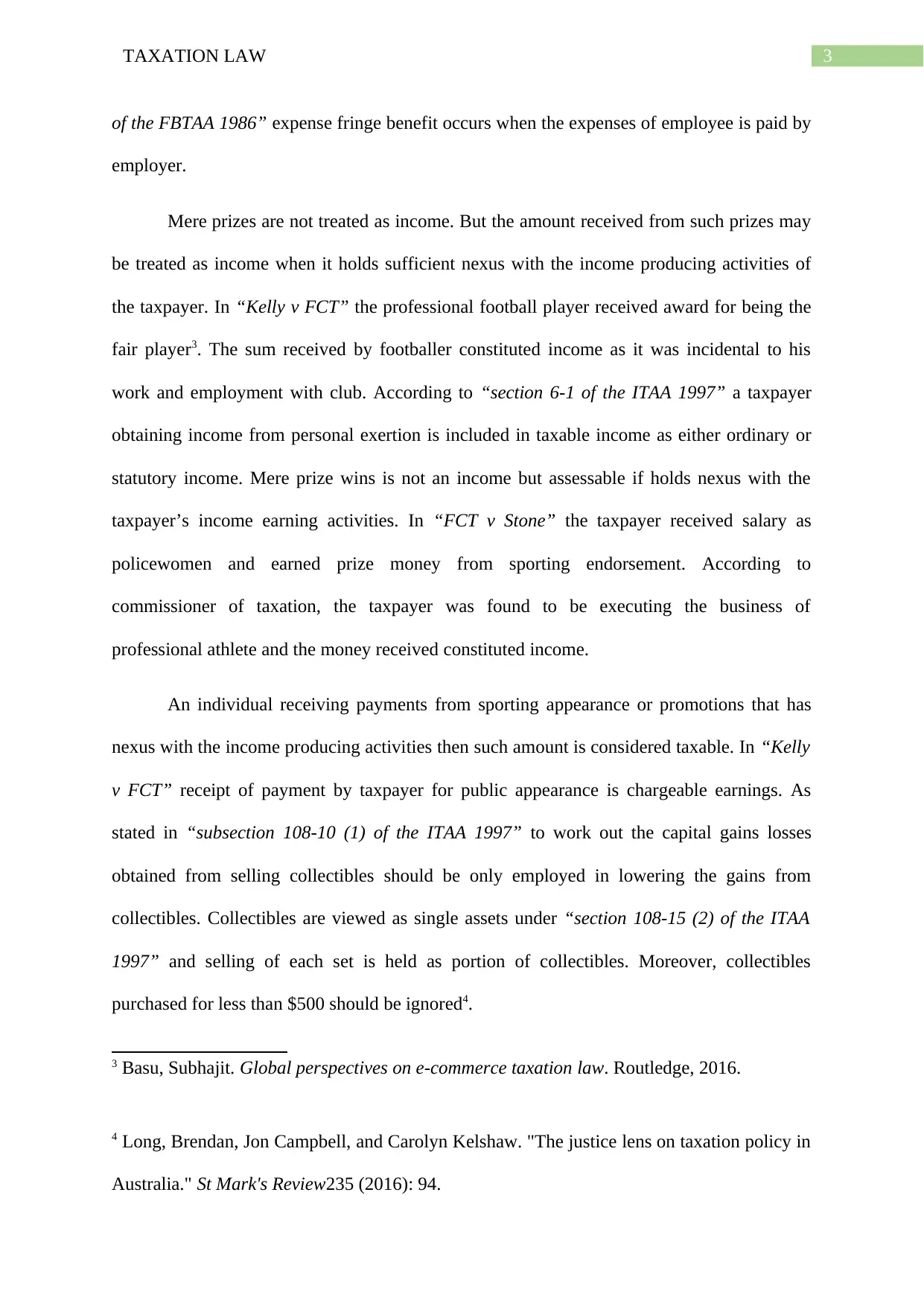
3TAXATION LAW
of the FBTAA 1986” expense fringe benefit occurs when the expenses of employee is paid by
employer.
Mere prizes are not treated as income. But the amount received from such prizes may
be treated as income when it holds sufficient nexus with the income producing activities of
the taxpayer. In “Kelly v FCT” the professional football player received award for being the
fair player3. The sum received by footballer constituted income as it was incidental to his
work and employment with club. According to “section 6-1 of the ITAA 1997” a taxpayer
obtaining income from personal exertion is included in taxable income as either ordinary or
statutory income. Mere prize wins is not an income but assessable if holds nexus with the
taxpayer’s income earning activities. In “FCT v Stone” the taxpayer received salary as
policewomen and earned prize money from sporting endorsement. According to
commissioner of taxation, the taxpayer was found to be executing the business of
professional athlete and the money received constituted income.
An individual receiving payments from sporting appearance or promotions that has
nexus with the income producing activities then such amount is considered taxable. In “Kelly
v FCT” receipt of payment by taxpayer for public appearance is chargeable earnings. As
stated in “subsection 108-10 (1) of the ITAA 1997” to work out the capital gains losses
obtained from selling collectibles should be only employed in lowering the gains from
collectibles. Collectibles are viewed as single assets under “section 108-15 (2) of the ITAA
1997” and selling of each set is held as portion of collectibles. Moreover, collectibles
purchased for less than $500 should be ignored4.
3 Basu, Subhajit. Global perspectives on e-commerce taxation law. Routledge, 2016.
4 Long, Brendan, Jon Campbell, and Carolyn Kelshaw. "The justice lens on taxation policy in
Australia." St Mark's Review235 (2016): 94.
of the FBTAA 1986” expense fringe benefit occurs when the expenses of employee is paid by
employer.
Mere prizes are not treated as income. But the amount received from such prizes may
be treated as income when it holds sufficient nexus with the income producing activities of
the taxpayer. In “Kelly v FCT” the professional football player received award for being the
fair player3. The sum received by footballer constituted income as it was incidental to his
work and employment with club. According to “section 6-1 of the ITAA 1997” a taxpayer
obtaining income from personal exertion is included in taxable income as either ordinary or
statutory income. Mere prize wins is not an income but assessable if holds nexus with the
taxpayer’s income earning activities. In “FCT v Stone” the taxpayer received salary as
policewomen and earned prize money from sporting endorsement. According to
commissioner of taxation, the taxpayer was found to be executing the business of
professional athlete and the money received constituted income.
An individual receiving payments from sporting appearance or promotions that has
nexus with the income producing activities then such amount is considered taxable. In “Kelly
v FCT” receipt of payment by taxpayer for public appearance is chargeable earnings. As
stated in “subsection 108-10 (1) of the ITAA 1997” to work out the capital gains losses
obtained from selling collectibles should be only employed in lowering the gains from
collectibles. Collectibles are viewed as single assets under “section 108-15 (2) of the ITAA
1997” and selling of each set is held as portion of collectibles. Moreover, collectibles
purchased for less than $500 should be ignored4.
3 Basu, Subhajit. Global perspectives on e-commerce taxation law. Routledge, 2016.
4 Long, Brendan, Jon Campbell, and Carolyn Kelshaw. "The justice lens on taxation policy in
Australia." St Mark's Review235 (2016): 94.
Secure Best Marks with AI Grader
Need help grading? Try our AI Grader for instant feedback on your assignments.
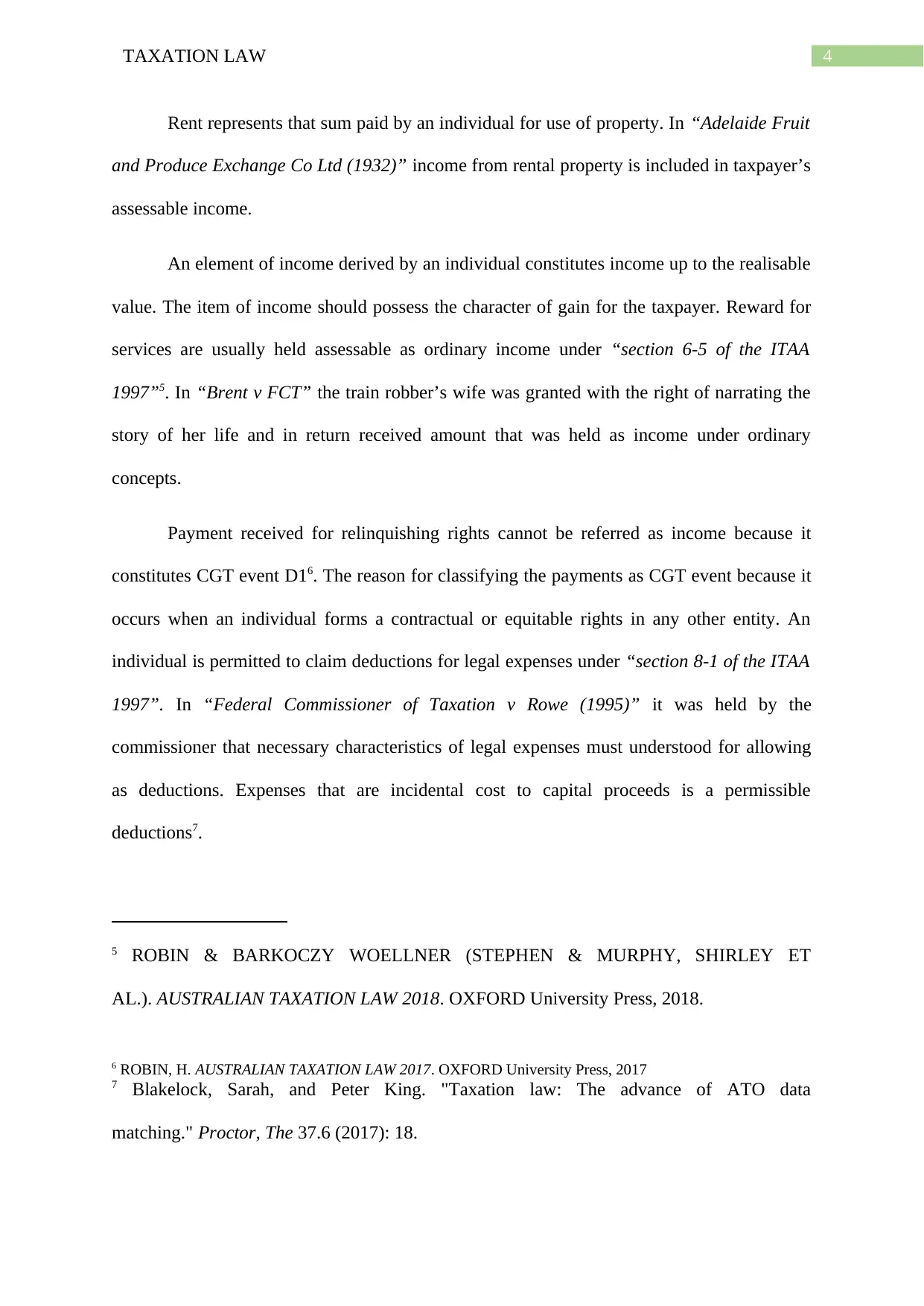
4TAXATION LAW
Rent represents that sum paid by an individual for use of property. In “Adelaide Fruit
and Produce Exchange Co Ltd (1932)” income from rental property is included in taxpayer’s
assessable income.
An element of income derived by an individual constitutes income up to the realisable
value. The item of income should possess the character of gain for the taxpayer. Reward for
services are usually held assessable as ordinary income under “section 6-5 of the ITAA
1997”5. In “Brent v FCT” the train robber’s wife was granted with the right of narrating the
story of her life and in return received amount that was held as income under ordinary
concepts.
Payment received for relinquishing rights cannot be referred as income because it
constitutes CGT event D16. The reason for classifying the payments as CGT event because it
occurs when an individual forms a contractual or equitable rights in any other entity. An
individual is permitted to claim deductions for legal expenses under “section 8-1 of the ITAA
1997”. In “Federal Commissioner of Taxation v Rowe (1995)” it was held by the
commissioner that necessary characteristics of legal expenses must understood for allowing
as deductions. Expenses that are incidental cost to capital proceeds is a permissible
deductions7.
5 ROBIN & BARKOCZY WOELLNER (STEPHEN & MURPHY, SHIRLEY ET
AL.). AUSTRALIAN TAXATION LAW 2018. OXFORD University Press, 2018.
6 ROBIN, H. AUSTRALIAN TAXATION LAW 2017. OXFORD University Press, 2017
7 Blakelock, Sarah, and Peter King. "Taxation law: The advance of ATO data
matching." Proctor, The 37.6 (2017): 18.
Rent represents that sum paid by an individual for use of property. In “Adelaide Fruit
and Produce Exchange Co Ltd (1932)” income from rental property is included in taxpayer’s
assessable income.
An element of income derived by an individual constitutes income up to the realisable
value. The item of income should possess the character of gain for the taxpayer. Reward for
services are usually held assessable as ordinary income under “section 6-5 of the ITAA
1997”5. In “Brent v FCT” the train robber’s wife was granted with the right of narrating the
story of her life and in return received amount that was held as income under ordinary
concepts.
Payment received for relinquishing rights cannot be referred as income because it
constitutes CGT event D16. The reason for classifying the payments as CGT event because it
occurs when an individual forms a contractual or equitable rights in any other entity. An
individual is permitted to claim deductions for legal expenses under “section 8-1 of the ITAA
1997”. In “Federal Commissioner of Taxation v Rowe (1995)” it was held by the
commissioner that necessary characteristics of legal expenses must understood for allowing
as deductions. Expenses that are incidental cost to capital proceeds is a permissible
deductions7.
5 ROBIN & BARKOCZY WOELLNER (STEPHEN & MURPHY, SHIRLEY ET
AL.). AUSTRALIAN TAXATION LAW 2018. OXFORD University Press, 2018.
6 ROBIN, H. AUSTRALIAN TAXATION LAW 2017. OXFORD University Press, 2017
7 Blakelock, Sarah, and Peter King. "Taxation law: The advance of ATO data
matching." Proctor, The 37.6 (2017): 18.
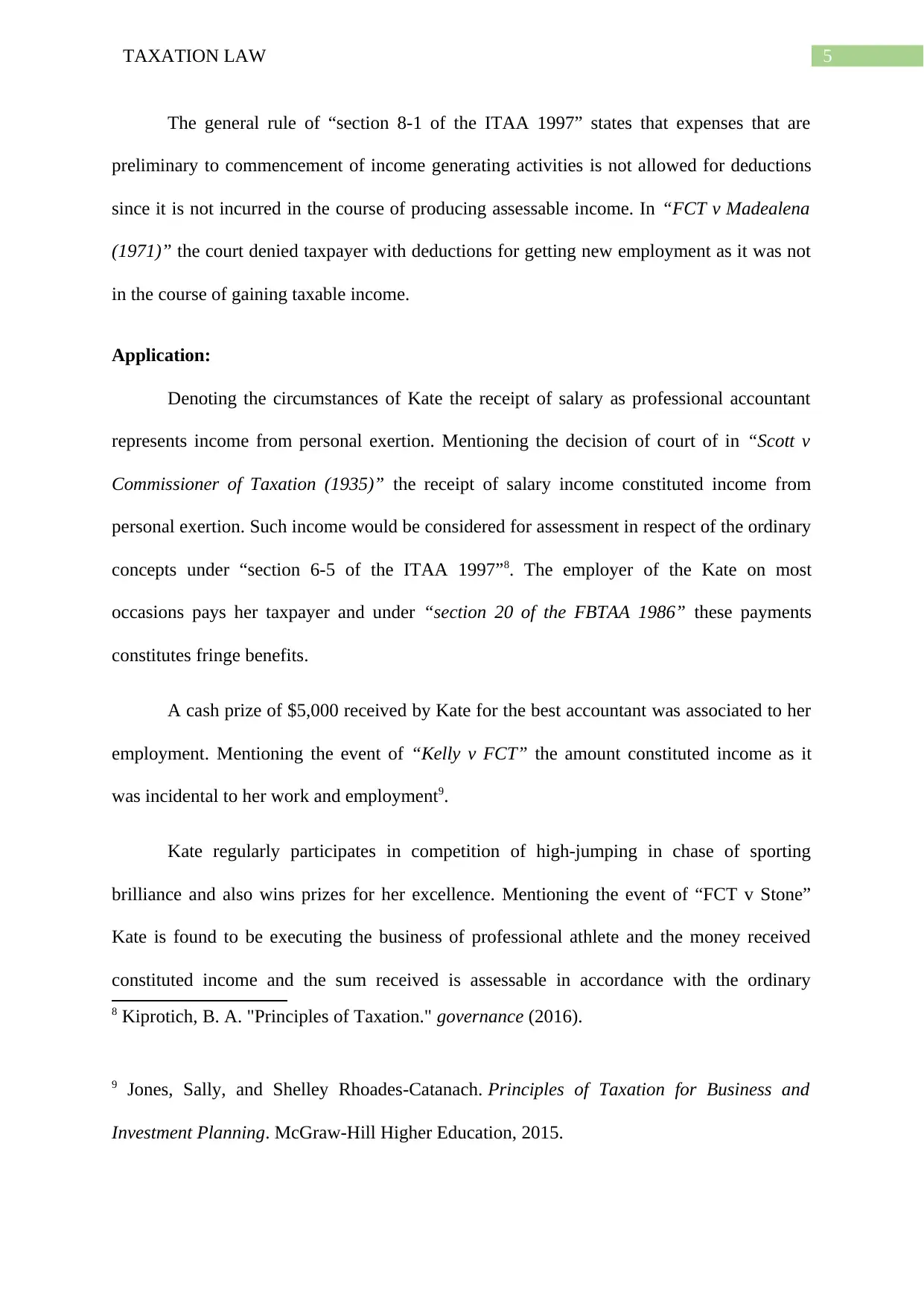
5TAXATION LAW
The general rule of “section 8-1 of the ITAA 1997” states that expenses that are
preliminary to commencement of income generating activities is not allowed for deductions
since it is not incurred in the course of producing assessable income. In “FCT v Madealena
(1971)” the court denied taxpayer with deductions for getting new employment as it was not
in the course of gaining taxable income.
Application:
Denoting the circumstances of Kate the receipt of salary as professional accountant
represents income from personal exertion. Mentioning the decision of court of in “Scott v
Commissioner of Taxation (1935)” the receipt of salary income constituted income from
personal exertion. Such income would be considered for assessment in respect of the ordinary
concepts under “section 6-5 of the ITAA 1997”8. The employer of the Kate on most
occasions pays her taxpayer and under “section 20 of the FBTAA 1986” these payments
constitutes fringe benefits.
A cash prize of $5,000 received by Kate for the best accountant was associated to her
employment. Mentioning the event of “Kelly v FCT” the amount constituted income as it
was incidental to her work and employment9.
Kate regularly participates in competition of high-jumping in chase of sporting
brilliance and also wins prizes for her excellence. Mentioning the event of “FCT v Stone”
Kate is found to be executing the business of professional athlete and the money received
constituted income and the sum received is assessable in accordance with the ordinary
8 Kiprotich, B. A. "Principles of Taxation." governance (2016).
9 Jones, Sally, and Shelley Rhoades-Catanach. Principles of Taxation for Business and
Investment Planning. McGraw-Hill Higher Education, 2015.
The general rule of “section 8-1 of the ITAA 1997” states that expenses that are
preliminary to commencement of income generating activities is not allowed for deductions
since it is not incurred in the course of producing assessable income. In “FCT v Madealena
(1971)” the court denied taxpayer with deductions for getting new employment as it was not
in the course of gaining taxable income.
Application:
Denoting the circumstances of Kate the receipt of salary as professional accountant
represents income from personal exertion. Mentioning the decision of court of in “Scott v
Commissioner of Taxation (1935)” the receipt of salary income constituted income from
personal exertion. Such income would be considered for assessment in respect of the ordinary
concepts under “section 6-5 of the ITAA 1997”8. The employer of the Kate on most
occasions pays her taxpayer and under “section 20 of the FBTAA 1986” these payments
constitutes fringe benefits.
A cash prize of $5,000 received by Kate for the best accountant was associated to her
employment. Mentioning the event of “Kelly v FCT” the amount constituted income as it
was incidental to her work and employment9.
Kate regularly participates in competition of high-jumping in chase of sporting
brilliance and also wins prizes for her excellence. Mentioning the event of “FCT v Stone”
Kate is found to be executing the business of professional athlete and the money received
constituted income and the sum received is assessable in accordance with the ordinary
8 Kiprotich, B. A. "Principles of Taxation." governance (2016).
9 Jones, Sally, and Shelley Rhoades-Catanach. Principles of Taxation for Business and
Investment Planning. McGraw-Hill Higher Education, 2015.
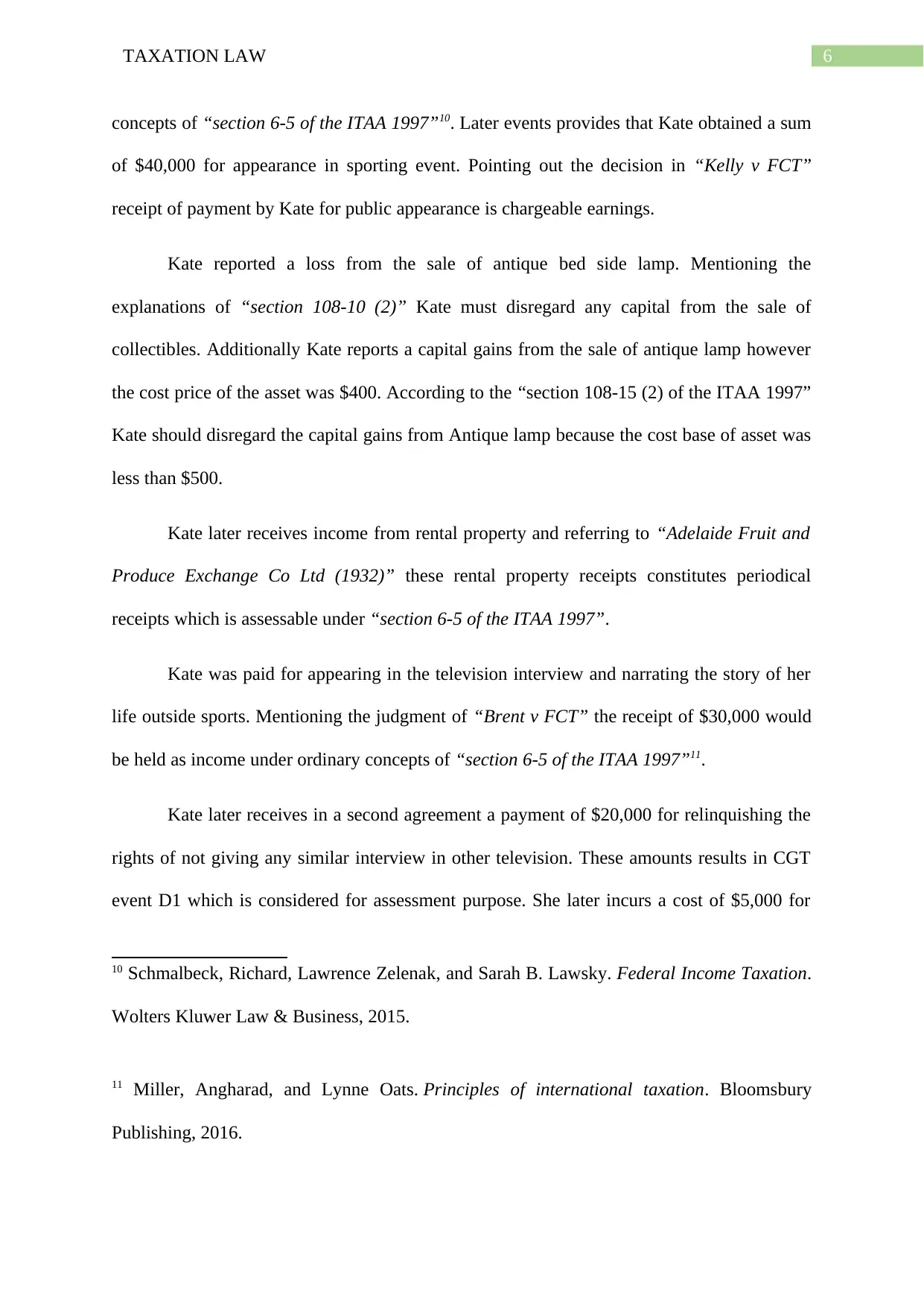
6TAXATION LAW
concepts of “section 6-5 of the ITAA 1997”10. Later events provides that Kate obtained a sum
of $40,000 for appearance in sporting event. Pointing out the decision in “Kelly v FCT”
receipt of payment by Kate for public appearance is chargeable earnings.
Kate reported a loss from the sale of antique bed side lamp. Mentioning the
explanations of “section 108-10 (2)” Kate must disregard any capital from the sale of
collectibles. Additionally Kate reports a capital gains from the sale of antique lamp however
the cost price of the asset was $400. According to the “section 108-15 (2) of the ITAA 1997”
Kate should disregard the capital gains from Antique lamp because the cost base of asset was
less than $500.
Kate later receives income from rental property and referring to “Adelaide Fruit and
Produce Exchange Co Ltd (1932)” these rental property receipts constitutes periodical
receipts which is assessable under “section 6-5 of the ITAA 1997”.
Kate was paid for appearing in the television interview and narrating the story of her
life outside sports. Mentioning the judgment of “Brent v FCT” the receipt of $30,000 would
be held as income under ordinary concepts of “section 6-5 of the ITAA 1997”11.
Kate later receives in a second agreement a payment of $20,000 for relinquishing the
rights of not giving any similar interview in other television. These amounts results in CGT
event D1 which is considered for assessment purpose. She later incurs a cost of $5,000 for
10 Schmalbeck, Richard, Lawrence Zelenak, and Sarah B. Lawsky. Federal Income Taxation.
Wolters Kluwer Law & Business, 2015.
11 Miller, Angharad, and Lynne Oats. Principles of international taxation. Bloomsbury
Publishing, 2016.
concepts of “section 6-5 of the ITAA 1997”10. Later events provides that Kate obtained a sum
of $40,000 for appearance in sporting event. Pointing out the decision in “Kelly v FCT”
receipt of payment by Kate for public appearance is chargeable earnings.
Kate reported a loss from the sale of antique bed side lamp. Mentioning the
explanations of “section 108-10 (2)” Kate must disregard any capital from the sale of
collectibles. Additionally Kate reports a capital gains from the sale of antique lamp however
the cost price of the asset was $400. According to the “section 108-15 (2) of the ITAA 1997”
Kate should disregard the capital gains from Antique lamp because the cost base of asset was
less than $500.
Kate later receives income from rental property and referring to “Adelaide Fruit and
Produce Exchange Co Ltd (1932)” these rental property receipts constitutes periodical
receipts which is assessable under “section 6-5 of the ITAA 1997”.
Kate was paid for appearing in the television interview and narrating the story of her
life outside sports. Mentioning the judgment of “Brent v FCT” the receipt of $30,000 would
be held as income under ordinary concepts of “section 6-5 of the ITAA 1997”11.
Kate later receives in a second agreement a payment of $20,000 for relinquishing the
rights of not giving any similar interview in other television. These amounts results in CGT
event D1 which is considered for assessment purpose. She later incurs a cost of $5,000 for
10 Schmalbeck, Richard, Lawrence Zelenak, and Sarah B. Lawsky. Federal Income Taxation.
Wolters Kluwer Law & Business, 2015.
11 Miller, Angharad, and Lynne Oats. Principles of international taxation. Bloomsbury
Publishing, 2016.
Paraphrase This Document
Need a fresh take? Get an instant paraphrase of this document with our AI Paraphraser
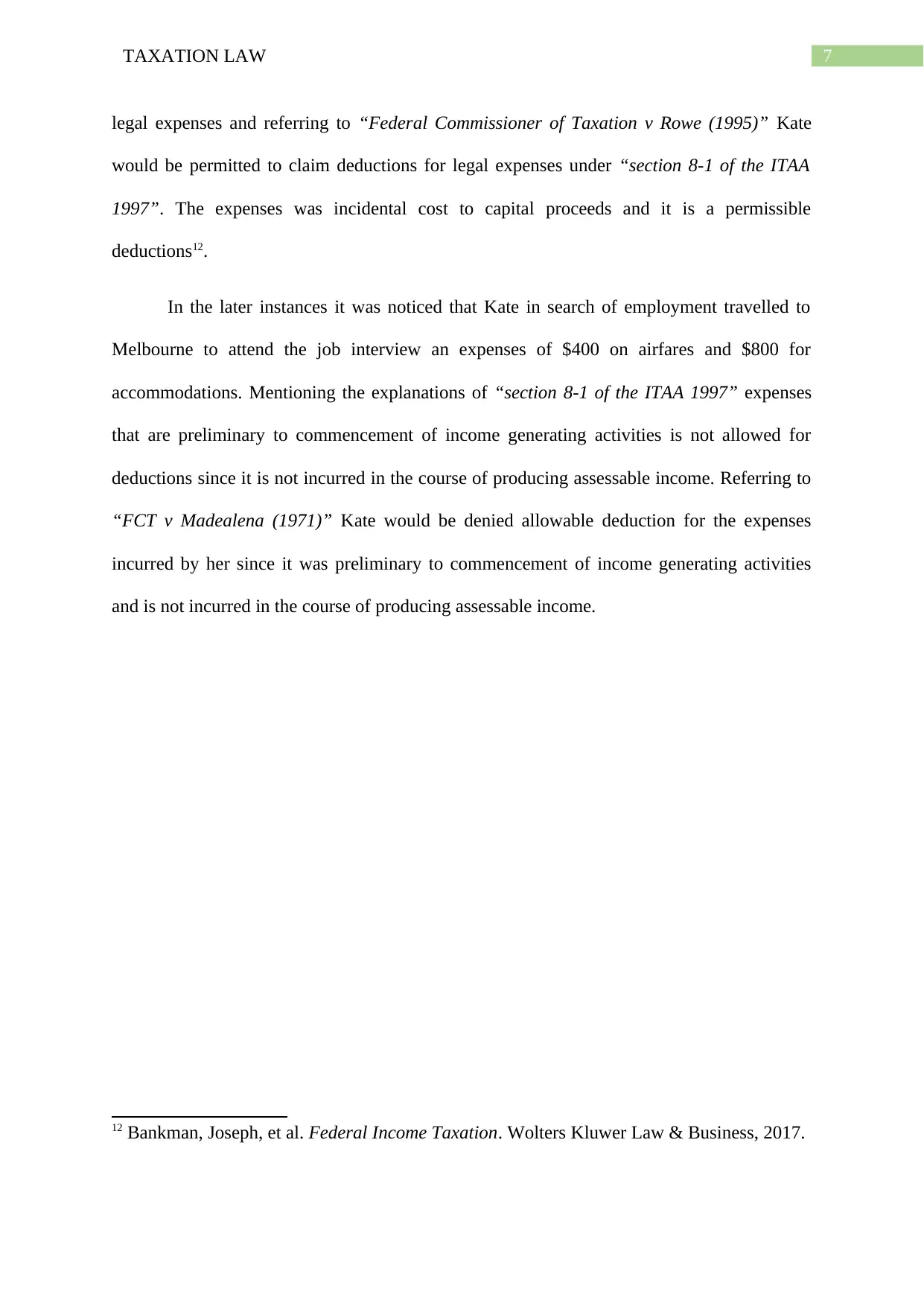
7TAXATION LAW
legal expenses and referring to “Federal Commissioner of Taxation v Rowe (1995)” Kate
would be permitted to claim deductions for legal expenses under “section 8-1 of the ITAA
1997”. The expenses was incidental cost to capital proceeds and it is a permissible
deductions12.
In the later instances it was noticed that Kate in search of employment travelled to
Melbourne to attend the job interview an expenses of $400 on airfares and $800 for
accommodations. Mentioning the explanations of “section 8-1 of the ITAA 1997” expenses
that are preliminary to commencement of income generating activities is not allowed for
deductions since it is not incurred in the course of producing assessable income. Referring to
“FCT v Madealena (1971)” Kate would be denied allowable deduction for the expenses
incurred by her since it was preliminary to commencement of income generating activities
and is not incurred in the course of producing assessable income.
12 Bankman, Joseph, et al. Federal Income Taxation. Wolters Kluwer Law & Business, 2017.
legal expenses and referring to “Federal Commissioner of Taxation v Rowe (1995)” Kate
would be permitted to claim deductions for legal expenses under “section 8-1 of the ITAA
1997”. The expenses was incidental cost to capital proceeds and it is a permissible
deductions12.
In the later instances it was noticed that Kate in search of employment travelled to
Melbourne to attend the job interview an expenses of $400 on airfares and $800 for
accommodations. Mentioning the explanations of “section 8-1 of the ITAA 1997” expenses
that are preliminary to commencement of income generating activities is not allowed for
deductions since it is not incurred in the course of producing assessable income. Referring to
“FCT v Madealena (1971)” Kate would be denied allowable deduction for the expenses
incurred by her since it was preliminary to commencement of income generating activities
and is not incurred in the course of producing assessable income.
12 Bankman, Joseph, et al. Federal Income Taxation. Wolters Kluwer Law & Business, 2017.

8TAXATION LAW
Particulars Amount ($) Amount ($)
Assessable Income
Income from Salaries
Salary from Accounting Firm 100000
Winning from Prize Money 40000
Australian Sourced Rental Income 30000
Receipt from appearance on sporting evets 40000
Consideration from TV Show 30000
Cash Award 5000
Payment from TV Considerations 20000
Total Assessable Income 265000
Allowable Deductions
Legal Fees 5000
Other Allowable Deductions 170000
Total Allowable Expenditure 175000
Total Taxable Income 90000
Basic Income Tax Liability 20797
Calculations of Taxable Income
In the books of Kate
For the year ended 2017/18
Working Note for Basic Income Tax Liability:
= $90,000 – $87,000 = $3,000
= $3000 x 37% = $1,110
= 19,822 + $1,110 = 20,392
Basic Income Tax Liability = $20,932
Conclusion:
The case of Kate can be concluded by stating that the amount derived from the salary
are held as assessable income from personal exertion. In accordance with the section “section
Particulars Amount ($) Amount ($)
Assessable Income
Income from Salaries
Salary from Accounting Firm 100000
Winning from Prize Money 40000
Australian Sourced Rental Income 30000
Receipt from appearance on sporting evets 40000
Consideration from TV Show 30000
Cash Award 5000
Payment from TV Considerations 20000
Total Assessable Income 265000
Allowable Deductions
Legal Fees 5000
Other Allowable Deductions 170000
Total Allowable Expenditure 175000
Total Taxable Income 90000
Basic Income Tax Liability 20797
Calculations of Taxable Income
In the books of Kate
For the year ended 2017/18
Working Note for Basic Income Tax Liability:
= $90,000 – $87,000 = $3,000
= $3000 x 37% = $1,110
= 19,822 + $1,110 = 20,392
Basic Income Tax Liability = $20,932
Conclusion:
The case of Kate can be concluded by stating that the amount derived from the salary
are held as assessable income from personal exertion. In accordance with the section “section
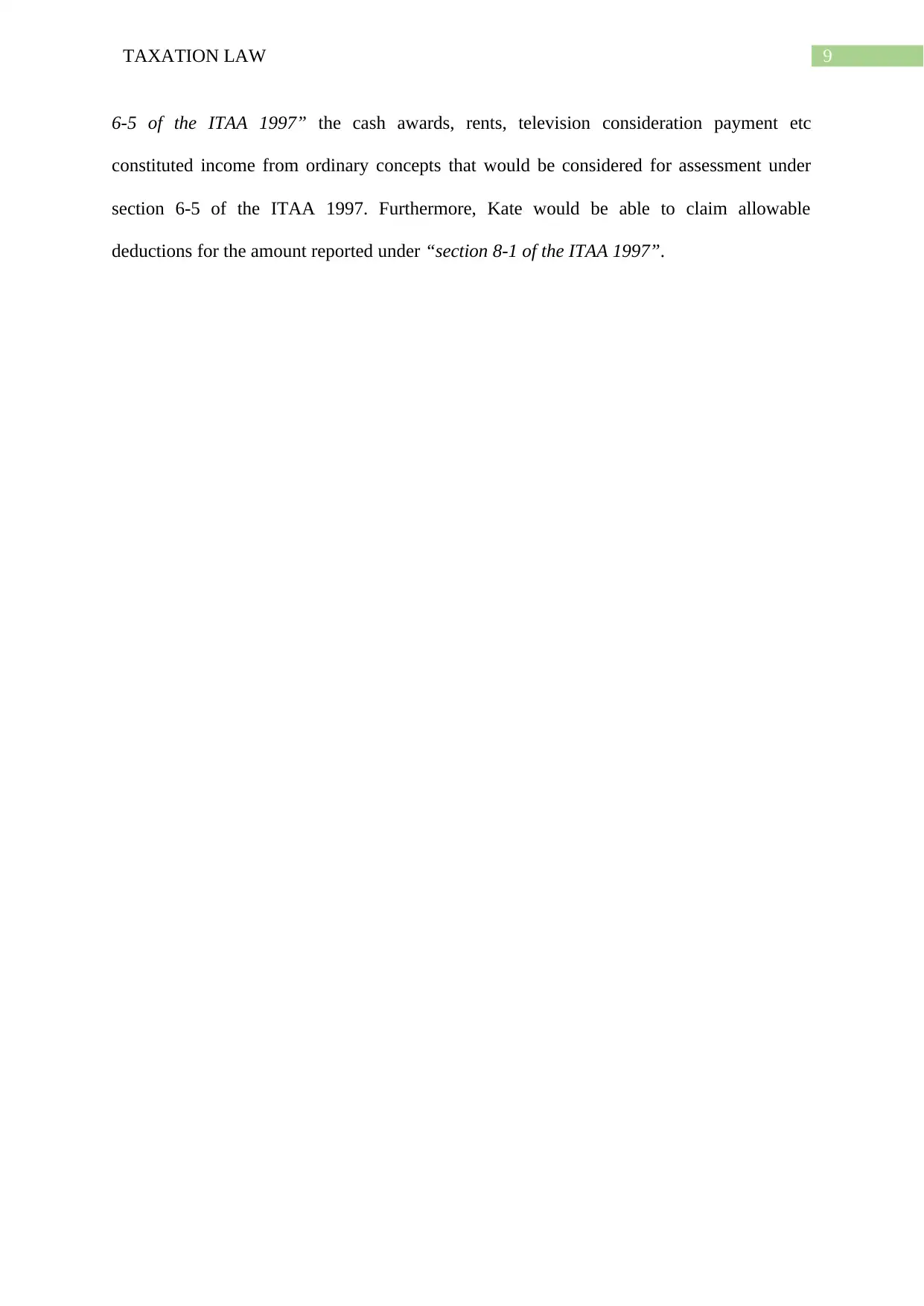
9TAXATION LAW
6-5 of the ITAA 1997” the cash awards, rents, television consideration payment etc
constituted income from ordinary concepts that would be considered for assessment under
section 6-5 of the ITAA 1997. Furthermore, Kate would be able to claim allowable
deductions for the amount reported under “section 8-1 of the ITAA 1997”.
6-5 of the ITAA 1997” the cash awards, rents, television consideration payment etc
constituted income from ordinary concepts that would be considered for assessment under
section 6-5 of the ITAA 1997. Furthermore, Kate would be able to claim allowable
deductions for the amount reported under “section 8-1 of the ITAA 1997”.
Secure Best Marks with AI Grader
Need help grading? Try our AI Grader for instant feedback on your assignments.
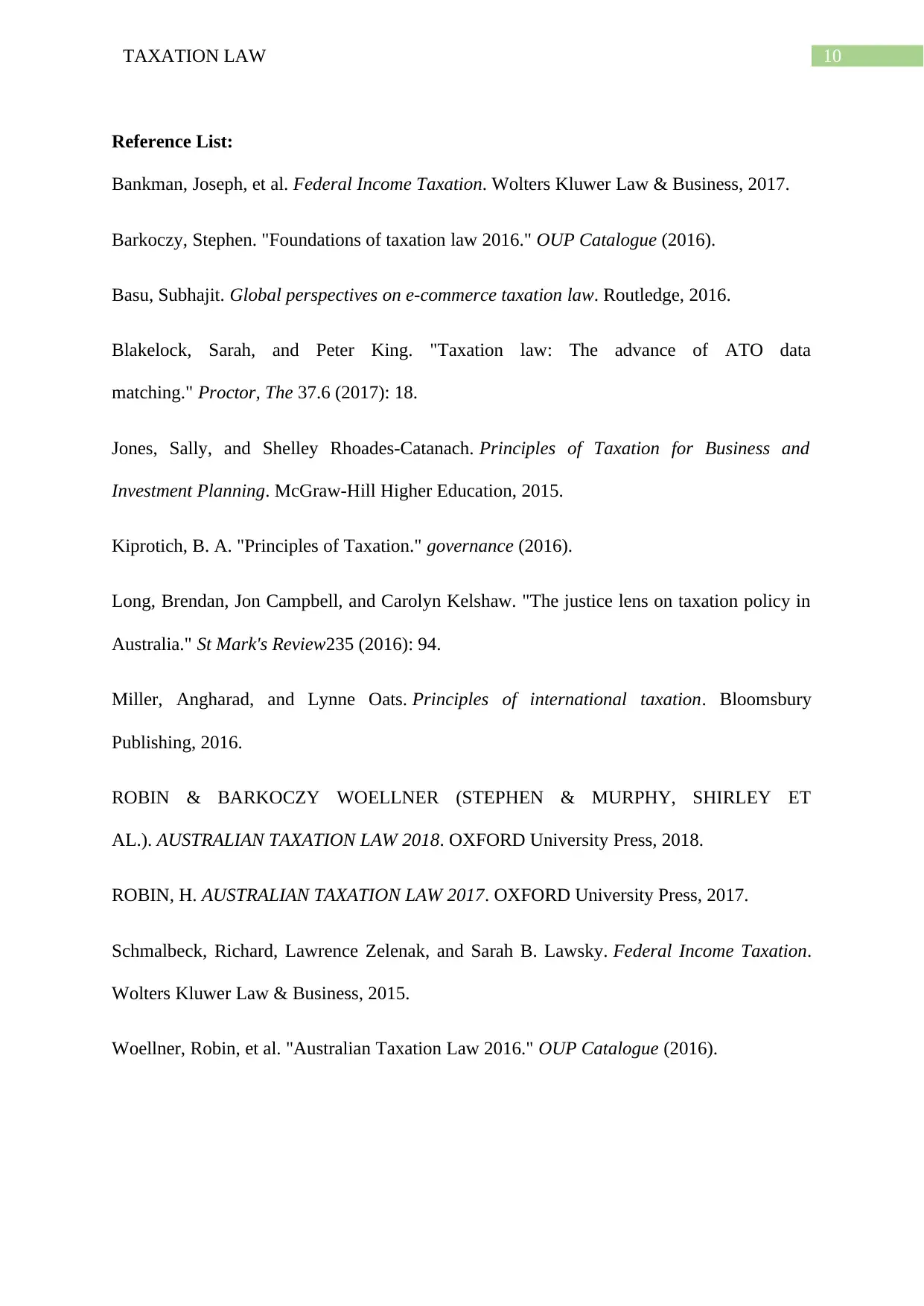
10TAXATION LAW
Reference List:
Bankman, Joseph, et al. Federal Income Taxation. Wolters Kluwer Law & Business, 2017.
Barkoczy, Stephen. "Foundations of taxation law 2016." OUP Catalogue (2016).
Basu, Subhajit. Global perspectives on e-commerce taxation law. Routledge, 2016.
Blakelock, Sarah, and Peter King. "Taxation law: The advance of ATO data
matching." Proctor, The 37.6 (2017): 18.
Jones, Sally, and Shelley Rhoades-Catanach. Principles of Taxation for Business and
Investment Planning. McGraw-Hill Higher Education, 2015.
Kiprotich, B. A. "Principles of Taxation." governance (2016).
Long, Brendan, Jon Campbell, and Carolyn Kelshaw. "The justice lens on taxation policy in
Australia." St Mark's Review235 (2016): 94.
Miller, Angharad, and Lynne Oats. Principles of international taxation. Bloomsbury
Publishing, 2016.
ROBIN & BARKOCZY WOELLNER (STEPHEN & MURPHY, SHIRLEY ET
AL.). AUSTRALIAN TAXATION LAW 2018. OXFORD University Press, 2018.
ROBIN, H. AUSTRALIAN TAXATION LAW 2017. OXFORD University Press, 2017.
Schmalbeck, Richard, Lawrence Zelenak, and Sarah B. Lawsky. Federal Income Taxation.
Wolters Kluwer Law & Business, 2015.
Woellner, Robin, et al. "Australian Taxation Law 2016." OUP Catalogue (2016).
Reference List:
Bankman, Joseph, et al. Federal Income Taxation. Wolters Kluwer Law & Business, 2017.
Barkoczy, Stephen. "Foundations of taxation law 2016." OUP Catalogue (2016).
Basu, Subhajit. Global perspectives on e-commerce taxation law. Routledge, 2016.
Blakelock, Sarah, and Peter King. "Taxation law: The advance of ATO data
matching." Proctor, The 37.6 (2017): 18.
Jones, Sally, and Shelley Rhoades-Catanach. Principles of Taxation for Business and
Investment Planning. McGraw-Hill Higher Education, 2015.
Kiprotich, B. A. "Principles of Taxation." governance (2016).
Long, Brendan, Jon Campbell, and Carolyn Kelshaw. "The justice lens on taxation policy in
Australia." St Mark's Review235 (2016): 94.
Miller, Angharad, and Lynne Oats. Principles of international taxation. Bloomsbury
Publishing, 2016.
ROBIN & BARKOCZY WOELLNER (STEPHEN & MURPHY, SHIRLEY ET
AL.). AUSTRALIAN TAXATION LAW 2018. OXFORD University Press, 2018.
ROBIN, H. AUSTRALIAN TAXATION LAW 2017. OXFORD University Press, 2017.
Schmalbeck, Richard, Lawrence Zelenak, and Sarah B. Lawsky. Federal Income Taxation.
Wolters Kluwer Law & Business, 2015.
Woellner, Robin, et al. "Australian Taxation Law 2016." OUP Catalogue (2016).
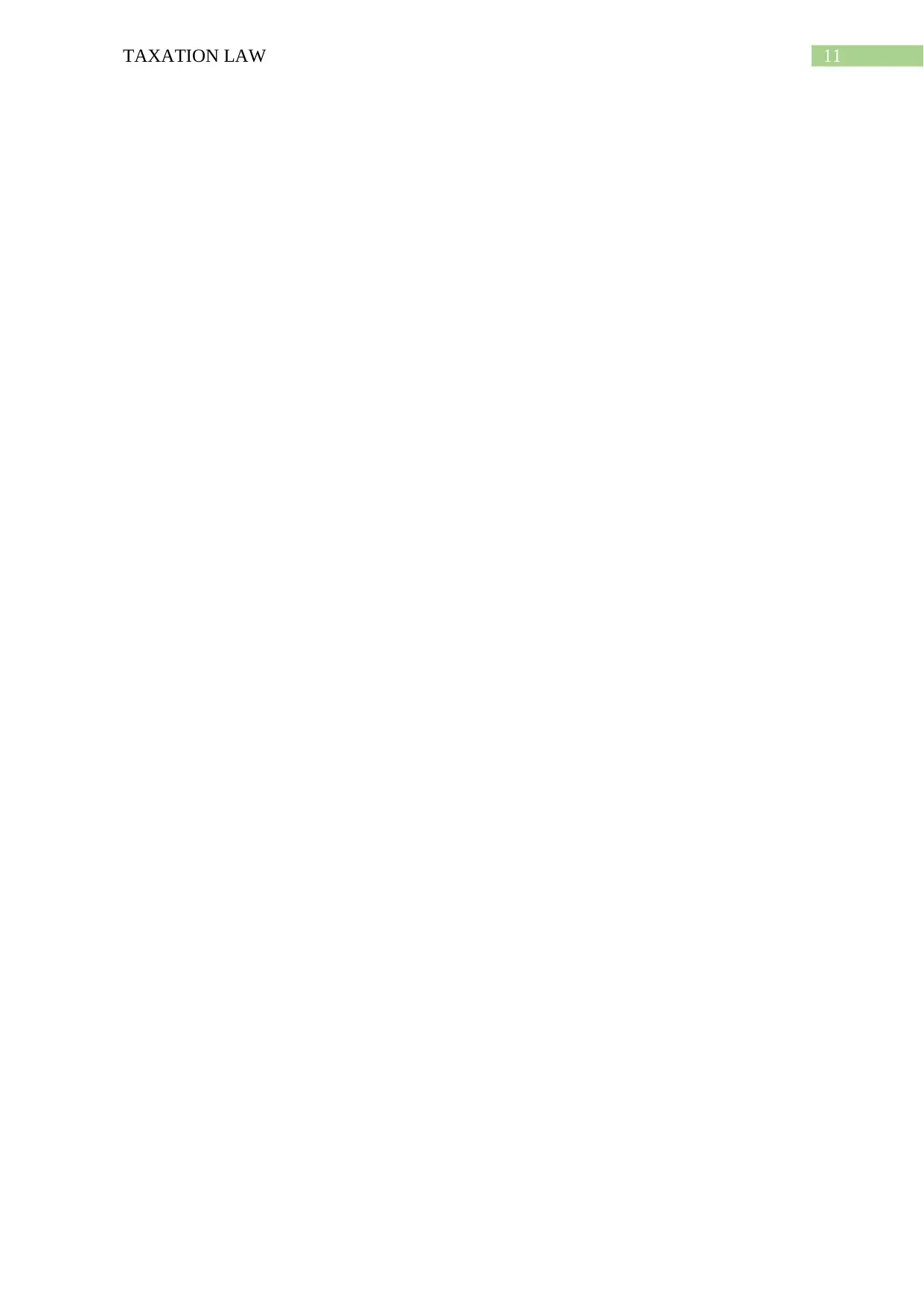
11TAXATION LAW
1 out of 12
Related Documents
Your All-in-One AI-Powered Toolkit for Academic Success.
+13062052269
info@desklib.com
Available 24*7 on WhatsApp / Email
![[object Object]](/_next/static/media/star-bottom.7253800d.svg)
Unlock your academic potential
© 2024 | Zucol Services PVT LTD | All rights reserved.





